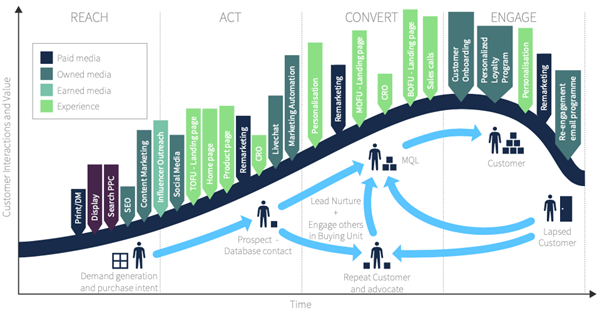Today we live in a digital world where customers, and that includes us, expect to receive a tailored, personalised service 24/7. According to google 75% of smartphone users expect immediate information whenever they open a website tab. And an astounding 51% believe that businesses should be contactable at any time, from any place. Historically these sort of number may have applied to B2C businesses, but that’s no longer the case. So what is always-on marketing and why do you need to invest if you’re operating in a B2B (business to business) market place?
What is ‘always-on’ marketing?
This refers to what you might describe as continuous marketing activities, activities that run 24/7, 365 days of the year. As the name suggests, always-on marketing is continuous. This means rather than a burst of marketing activity, this is a continuous trickling of marketing campaigns designed to engage your potential customers. By being constantly available to customers, always-on marketing allows businesses to build higher customer retention and increase their lead generation, winning more customers.
- Campaign – this is a burst of marketing activities for a fixed amount of time. This might include weekly or monthly email campaigns
- Always on – this is a drip of marketing activities, and a consistent and continuous marketing activities that lasts indefinitely
The following model from Marketing Insights may look familiar, as it represents the likely journey of your buyer or future customer. The Buyer Journey stages that a prospect moves through before finally buying from your business. The subtle difference here is the continuous loop that is created by ‘always-on’ marketing.

Three key reasons to implement an ‘always-on’ B2B marketing strategy?
As a B2B business, its more likely that you’ll have more conventional opening hours, so how will ‘always-on’ marketing work from a practical perspective? Firstly, lets think about this from your buyers perspective.
- We live in a 24/7 digital world. As online consumers, we can’t fathom the idea of encountering a ‘closed’ sign when we visit a website. The re is that the world wide web operates 24/7. If you don’t operate an ‘always-on’ marketing strategy, you could be giving your potential customers a ‘come back later’ sign, which may result in them going to a competitor
- 73% of B2B business related searches are done in the evening (source: LinkedIn). Your products and services are constantly being evaluated digitally, even when your physical office is closed
- 51% of business related searches are done at the weekend (source: LinkedIn). If you don’t operate an ‘always-on’ strategy you could be missing out on a lot of business opportunities
Finally, its always so important to remember to put your customer first and wherever possible, try to personalise and customise their experience as much as possible. Digital doesn’t need to feel impersonal.
What are the implications to your business?
Always-on marketing is about creating individual customer journeys that are dynamic and personalised. This can only be achieved consistently by using technology. Its what google calls ‘zero moment of truth’, where marketing actions are continuously driving and meeting customer demands in a never ending loop.
A word of caution; don’t treat everyone the same – there is no ‘one size fits all’ approach that will be successful. The goal is to be constantly available and accessible to your customers, whenever they are.
Tips to get started with ‘always-on’ marketing
It’s not easy, but the rewards will be worth it. It’s a big commitment, but it’s worth investing the time.
Infrastructure
You’ll need to start using automations which can be achieved using one of the many marketing automation and CRM systems and technology available to you. Automations allow you to personalise your marketing content and create relevant touchpoint for each customer.
Data
Capturing and using your data will deliver the best results. To create the most relevant and enagaing marketing materials and content you need to know as much about your audience as possible. And that all comes from data, and understanding the behaviour of your customer. Without data to support you, your blind. But don’t be put off, you can capture data and gradually build up greate knowledge of your customer as you go.
Content
When you’re communicating with your audience on a more frequent basis, you will need to have more content in the pipeline. This can be challenging but think about repurposing content and case studies that you have already created. Can they be used to create smaller, relevant items of content or converted into check-lists and ‘how-to’, assets that are useful and valuable to your audience?
Tips for success
Start small and build up. Focus on data collection and data analysis wherever possible and use this to improve your automations. Make full use of the marketing channels available to you such as
- Organic search and your SEO (search engine optimisation)
- Paid search
- Social media marketing
- Digital advertising such as retargeting which reminds people who have engaged with you
- E-mail marketing, including automated welcome letters and newsletters
- Automation and drip feed sequences utilising your content
- Trigger automations and sequences based on website visitor behaviour
- Website landing pages and product pages designed to convert visitors
If you’re looking for some support or need a helping hand to get started with your ‘always-on’ B2B strategy, get in touch.





